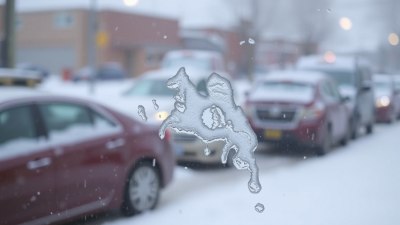What Causes Sudden Temperature Swings in Spring and Fall
Explore the reasons behind sudden temperature swings during spring and fall and understand the atmospheric processes involved.

Sudden temperature swings during spring and fall are common weather phenomena that can confuse even seasoned weather watchers. These shifts often seem unpredictable and can vary drastically within a day or over a few days. Understanding why these changes occur requires a look into atmospheric dynamics, seasonal transitions, and regional environmental factors.
Seasonal Transitions and Their Impact
Spring and fall are transitional seasons where the Earth's tilt and orbit change the angle of sunlight reaching different parts of the planet. This transition causes unstable atmospheric conditions because neither the cold air masses typical of winter nor the warm air masses of summer dominate entirely. As a result, the atmosphere becomes more reactive, with frequent conflicts between opposing air masses that contribute to temperature volatility.
During spring, the retreating cold air mass from winter clashes with intensifying warm air from the sun, creating fronts that lead to temperature swings. Similarly, in fall, warm air from the summer gradually gives way to cooler air masses moving in, causing the temperature to fluctuate dramatically as these air masses battle for dominance in the atmosphere.
The Role of Air Masses and Fronts
Air masses are large bodies of air with relatively uniform temperature and humidity characteristics, and they play a critical role in temperature swings. When hot and cold air masses meet, a front forms, which is the boundary between the two. Cold fronts and warm fronts influence temperatures significantly.
A cold front can cause a sudden drop in temperature as cold, dense air rushes in and displaces warmer air. Conversely, a warm front can result in a quick rise in temperature as warm air slides over retreating cold air. The passage of these fronts often occurs rapidly, causing noticeable temperature changes within hours.
Atmospheric Pressure Systems and Their Influence
High-pressure and low-pressure systems also impact temperature swings. High-pressure zones are often associated with clear skies and more significant temperature ranges between day and night, while low-pressure systems can bring cloud cover and precipitation that moderate temperature changes.
During spring and fall, shifting pressure patterns contribute to the instability of the air, encouraging the movement of air masses and fronts. The dynamic interplay of these systems can lead to abrupt transitions in local weather conditions, often reflecting as sudden jumps or drops in temperature.
The Effects of Jet Streams
Jet streams are fast-flowing ribbons of air located in the upper atmosphere that steer weather systems across the globe. The position and strength of jet streams change seasonally and have a major effect on temperature fluctuations.
In spring and fall, jet streams tend to be more active and can dip or rise sharply. When a jet stream moves south, it pulls cold polar air into lower latitudes, causing sudden cooling. When it shifts north, warmer air from southern regions can surge into cooler areas, causing a warmth spike. These rapid shifts in jet stream position align closely with the timing of temperature swings.
Local Geography and Microclimates
Local geographical features such as mountains, valleys, large bodies of water, and urban areas influence how temperature swings are experienced. Mountains can act as barriers that block or funnel air masses, intensifying temperature changes as air descends or rises through passes and slopes.
Bodies of water, like lakes and oceans, have high heat capacity and moderate the temperature of surrounding land. However, during transitional seasons, when water temperatures lag behind air temperatures, this can create sharp temperature gradients near coasts, leading to localized swings.
Urban heat islands, caused by concrete and asphalt absorbing and radiating heat, can cause temperature fluctuations between urban centers and rural surroundings, especially during spring and fall when ambient temperatures fluctuate widely.
The Influence of Sun Angle and Daylight Duration
Another important factor in temperature swings during these seasons is the changing angle of the sun and length of daylight. As the sun climbs higher in spring or lowers in fall, the amount of solar radiation changes daily. This variable solar input can cause daytime temperatures to rise considerably when the sun is strong, only to plunge after sunset when the heating source is removed.
In the transitional seasons, the shorter nights compared to winter do not always allow for a full equalization of heat loss and gain, resulting in more noticeable swings within a 24-hour period. These factors combined cause day-night temperature variability to be more pronounced than in summer or winter.
Additional Climatic Influences
Regional weather patterns such as upslope winds, valley drainage flows, and cold air pooling can exacerbate temperature swings. For instance, cold air pooling in valleys during the night can cause significant nighttime temperature drops, followed by rapid warming when the sun rises.
Furthermore, the presence or absence of vegetation and soil moisture levels can impact local temperatures; moist soils and transpiring plants tend to moderate temperature extremes, while dry areas heat and cool more rapidly.
Human Perception of Temperature Swings
Often, the perception of temperature swings is intensified by human indoor conditions and activity. Moving from warm indoor environments to cooler outdoors or vice versa during spring and fall makes the temperature changes palpable. Additionally, the contrast in clothing and preparedness for changing weather can make the swings feel sharper.
Understanding the scientific causes can help people prepare better for these changes, choose appropriate clothing, and manage energy use more effectively during transitional months.
The Impact on Ecosystems and Agriculture
Sudden temperature swings during spring and fall affect plant and animal life significantly. Early blossoms in plants can be damaged by unexpected cold snaps, while animals rely on consistent cues for migration and hibernation.
Farmers must watch these swings carefully because they can impact crop development or increase susceptibility to pests and diseases. Temperature fluctuations can also affect soil temperatures, altering seed germination and microbial activities critical to soil health.
Strategies for Forecasting and Mitigation
Weather forecasting technology has improved the detection of fronts, pressure changes, and jet stream positions that cause temperature swings. Meteorologists use computer models to predict these events, allowing for earlier warnings and better preparedness.
Mitigation efforts include planting frost-resistant crops, adjusting planting schedules, and creating microclimates in fields using windbreaks or cover crops. Urban planners can design green spaces that mitigate temperature extremes, helping communities adapt to variable spring and fall temperatures.
In conclusion, sudden temperature swings during spring and fall are caused by a complex interaction of atmospheric dynamics, seasonal changes, geographical influences, and solar patterns. Recognizing these factors enhances understanding of weather behavior and aids in planning for its effects across human and natural systems.











